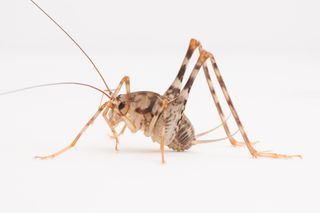Invasive Camel Crickets Widespread in US Homes

Camel crickets may have been largely overlooked by scientists over the past several decades, but the results of a new citizen science project, released today (Sept. 2), reveal the insects may outnumber humans in the United States.
What's more, the study found that an invasive species of camel cricket from Asia is now far more common in American basements than the native variety.
The study got its start when a cricket taxonomist at North Carolina State University found an invasive camel cricket in the home of a fellow researcher. ("Grad Student Too Busy, Annoyed to Care about Giant Bugs in Basement" was how Holly Menninger, director of public science in the Your Wild Life lab and co-author of the study, phrased it in the subheading of her blog post describing the cricket-infested house.) [7 Insects You'll Be Eating in the Future]
Camel crickets — also known as "sprickets," spider crickets and cave crickets — have an arched back and long hind legs. The ones scientists would expect to find in North America are thick-bodied and a mottled brown in color; they belong to the genus Ceuthophilus. An invasive species of camel cricket from Asia, Diestrammena asynamora, became established in the United States during the 19th century. It was dubbed the greenhouse camel cricket, and scientists thought it was rarely found outside of greenhouses. It has a banded pattern on its legs and is more slender than its American counterpart.
To determine how common all kinds of camel crickets are today, Menninger and her colleagues turned to the public. They solicited photos and physical specimens of camel crickets living in and around U.S. homes. They asked aspiring citizen scientists to fill out a survey on their own camel cricket sightings, when enrolling for an unrelated study on the microbial diversity of households. The researchers also had an open survey on their website, yourwildlife.org. (The team is still looking for data if you have camel cricket photos or observations to share.)
Most of the camel cricket observations were reported east of the Mississippi River. And the invasive camel crickets seemed to be much more common than Ceuthophilus insects, according to the results, published in the open-access journal Peer J. In North Carolina, for example, D. asynamora was present in 92 percent of households that submitted camel cricket samples. This species could also be extremely abundant. The researchers set up cricket traps around 10 homes in Raleigh, North Carolina. Over the course of two days, the researchers caught 50 individual D. asynamora crickets in a single yard.
"We don't know what kind of impact this species has on local ecosystems, though it's possible that the greenhouse camel cricket could be driving out native camel cricket species in homes," study leader Mary Jane Epps, a postdoctoral researcher at NC State, said in a statement.
Sign up for the Live Science daily newsletter now
Get the world’s most fascinating discoveries delivered straight to your inbox.
The scientists roughly estimated that there could be 700 million camel crickets, of all species, in and around homes across the eastern United States. Camel crickets don't pose any threat to humans, and they might not actually be such bad roommates.
"Because they are scavengers, camel crickets may actually provide an important service in our basements or garages, eating the dead stuff that accumulates there," Menninger explained in a statement.
Camel crickets indeed are not picky eaters. The authors of a study of Ceuthophilus foraging habits, published in the American Midland Naturalist in 2005, noted that camel crickets would eat anything from American cheese to dead fire ants to human feces to fallen fruit.
Follow Megan Gannon on Twitter and Google+. Follow us @livescience, Facebook & Google+. Original article on LiveScience.

